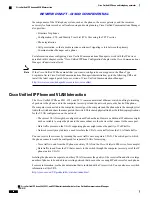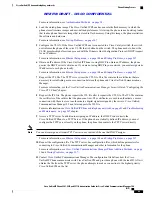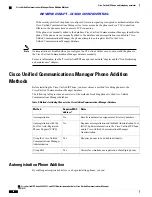
C H A P T E R
2
Cisco Unified IP Phone and telephony networks
Cisco Unified IP Phones enable you to communicate by using voice over a data network. To provide this
capability, IP phones depend upon and interact with several other key Cisco Unified IP Telephony components,
including Cisco Unified Communications Manager.
This chapter focuses on the interactions between the Cisco Unified IP Phone 8961, 9951, and 9971 and
Cisco Unified Communications Manager, DNS and DHCP servers, TFTP servers, and switches. The chapter
also describes phone power options.
For related information about voice and IP communications, see this URL:
http://www.cisco.com/en/US/products/sw/voicesw/index.html
This chapter provides an overview of the interaction between the Cisco Unified IP Phone and other key
components of the VoIP network. The chapter includes the following topics:
•
Cisco Unified IP Communications Product Interactions, page 41
•
Cisco Unified IP Phone Power, page 43
•
Phone Configuration Files, page 47
•
Phone Startup Process, page 48
•
Cisco Unified Communications Manager Phone Addition Methods, page 50
•
Cisco Unified IP Phone MAC Address Determination, page 52
Cisco Unified IP Communications Product Interactions
To function in the IP telephony network, the Cisco Unified IP Phone must connect to a network device, such
as a Cisco Catalyst switch. You must also register the Cisco Unified IP Phone with a Cisco
Unified Communications Manager system before sending and receiving calls.
Cisco Unified IP Phone and Cisco Unified Communications Manager Interaction
Cisco Unified Communications Manager is an open, industry-standard call processing system.
Cisco Unified Communications Manager software sets up and tears down calls between phones, integrating
traditional PBX functionality with the corporate IP network. Cisco Unified Communications Manager manages
Cisco Unified IP Phone 8961, 9951, and 9971 Administration Guide for Cisco Unified Communications Manager 10.0
(SIP)
41
















































